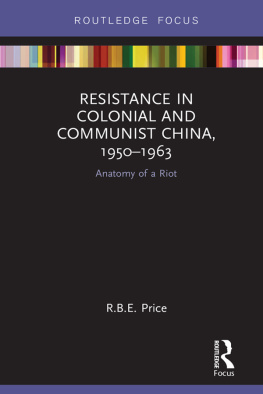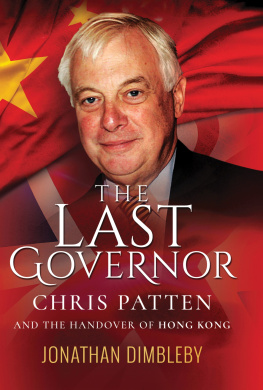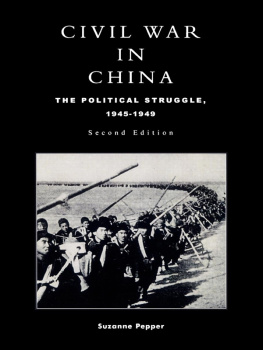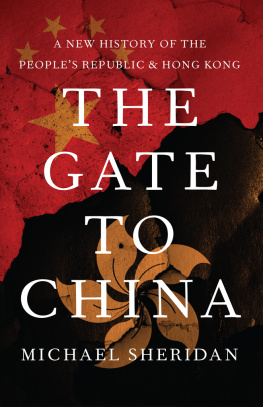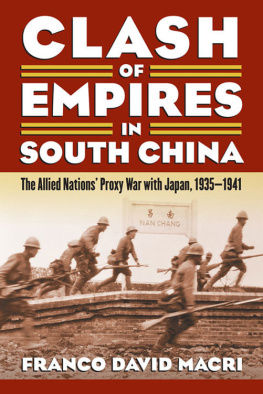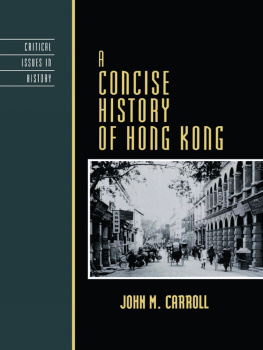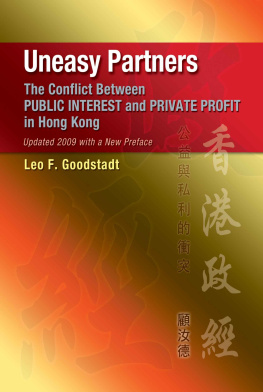Resistance in Colonial and Communist China, 19501963
The history of colonial East Asia is a human anatomy describing beneficial organs of foreign rule. Proclaiming itself a schematic diagram open to inspection, the anatomy of the late British Empire nevertheless obscured much more than it revealed. This analogy in Prices provocative Cold War history is not presented only as an insight on imperialism but deciphers competing nationalist ideologies, too. The Kuomintang contended vigorously against communist rule in southern China for a decade after the end of the civil war in 1949 and Chinese communists disparaged British colonialism in Hong Kong in a war of words peaking in 19561957. These clashes of will did not produce new rulers in either place. They informed a period of Sino-British strategic partnership based on recognition that a capitalist enclave in southern China had its uses.
By focusing on the Hong Kong region, Resistance in Colonial and Communist China compares anatomies of the British colonial government, the Chinese communists and stateless members of the remnant Kuomintang (19501963). Price asserts that after 1949, the colonial government of Hong Kong politically favoured the Kuomintang organised crime societies over their communist nationalist adversaries despite historiographical explanation that it favoured neither.
This book challenges traditional concepts of the British colonial government and its attitude towards communist China. It engages in current debates surrounding Britains past by presenting a particularly devious episode of late colonial history.
R.B.E. Price is a Lecturer-at-Law at Southern Cross University, Australia and has held visiting professorships across China. His other publications include Reading Colonies: Property and Control of the British Far East (2016, City University Press of Hong Kong), the biography of a Hong Kong land officer, Going Native: The Passions of Philip Jacks (2016, Australian Scholarly Publishing) and Violence and Emancipation in Colonial Ideology (forthcoming). His current project is a theoretical work, On Occupation.
First published 2019
by Routledge
2 Park Square, Milton Park, Abingdon, Oxon OX14 4RN
and by Routledge
52 Vanderbilt Avenue, New York, NY 10017
Routledge is an imprint of the Taylor & Francis Group, an informa business
2019 R.B.E. Price
The right of R.B.E. Price to be identified as author of this work has been asserted by him in accordance with sections 77 and 78 of the Copyright, Designs and Patents Act 1988.
All rights reserved. No part of this book may be reprinted or reproduced or utilised in any form or by any electronic, mechanical, or other means, now known or hereafter invented, including photocopying and recording, or in any information storage or retrieval system, without permission in writing from the publishers.
Trademark notice: Product or corporate names may be trademarks or registered trademarks, and are used only for identification and explanation without intent to infringe.
British Library Cataloguing-in-Publication Data
A catalogue record for this book is available from the British Library
Library of Congress Cataloging-in-Publication Data
Names: Price, Rohan, author.
Title: Resistance in colonial and communist China (19501963).
Description: Abingdon, Oxon ; New York, NY : Routledge, 2019. | Includes bibliographical references and index.
Identifiers: LCCN 2018047700 | ISBN 9781138388857 (hardback) | ISBN 9780429424335 (ebook)
Subjects: LCSH: Hong Kong (China)History20th century. | Hong Kong (China)Politics and government20th century. | Great BritainColoniesAsiaAdministration. | ChinaForeign relationsGreat Britain. | Great BritainForeign relationsChina.
Classification: LCC DS796.H757 P75 2019 | DDC 951.2505dc23
LC record available at https://lccn.loc.gov/2018047700
ISBN: 978-1-138-38885-7 (hbk)
ISBN: 978-0-429-42433-5 (ebk)
Typeset in Galliard
by Apex CoVantage, LLC
The civil war in China did not end neatly on 1 October 1949. Political and militant resistance to communism was a strong pulse of southern Chinas history in the period between 1950 and 1963. Colonialism was resisted too. Chinese communist post-riot criticisms of the inadequate and biased compensation practices of British colonialism in Hong Kong in 1957 is one example. Another example was afforded by Leftist protests at the colonys indifference to Chinese Nationalist sabotage raids in the new communist republic throughout the late 1950s.
Whether cold war conflict found outlet in a heated war of words between familiar sparring partners or came in a message sent to claim responsibility for a bomb detonated in a railway station, there were conventions to textual and spoken violence for example, what a party said was not a reliable indicator of who it was. I say this is a general principle, before any particular exegesis can begin or the officeholders in the history clubhouse confirm the minutes of their AGM. Colonialism, communism and bourgeois nationalism each had an anatomy that disguised underlying realities in the form of a hidden constituency of private motives projecting an objective political aim. This is my central claim.
This history tries to unravel the private motives of nationalism. In doing so, I wing my way through a no-fly zone clouded by Kuomintang (KMT) diatribe and Chinese Communist (CCP) distortions and land my own motive in a barely free land where things colonisers can never bring themselves to admit are spoken about openly and fervently by locals. It is as if the Indian Mutiny retaliations, the starvation of Bengal, hunting the Mau Mau, the dispersals of South East Queensland, massacres at Batang Kali, Amritsar and Myall Creek all happened in one town, in the same country, yesterday. Refuelling on this high-octane rage, I fly on my only aims are to reach altitude and describe the difference between mountains and seas below. How could anyone not know the difference? I only record the obvious vistas sprawling and abutting below me because we have lost our habit of arguing about topography as new or ancient, in tectonic tension, as enemies crumbling enemies, or skidding lightly enough to co-exist in the same world.
My choice of the word anatomy is purposeful. Yet what does the word anatomy bring to mind? Perhaps one thinks of a branch of biology dedicated to depicting human organs in cross-section or relief illustrations? The product of centuries of dissection, anatomy is a science of show and tell about the human body. What needs to be known is in plain sight. A colonial history claims an authoritative ground. Like a medical anatomy, it acknowledges no variation to its schema of the body, views its processes as verified and routine, and regards empiricism not as a dialectical smash of knowledges but as a tightly refereed corridor.

